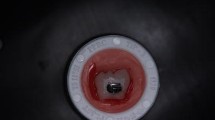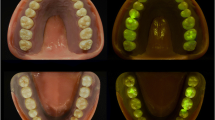Abstract
The aim of this study was to determine the influence of thickness and aging on the intrinsic fluorescence of sealing materials and their ability to block fluorescence from the underlying surface as assessed using a laser fluorescence device. Cavities of 0.5 mm and 1 mm depth were drilled into acrylic boards which were placed over two surfaces with different fluorescence properties: a low-fluorescence surface, to assess the intrinsic fluorescence of the sealing materials, and a high-fluorescence surface, to assess the fluorescence-blocking ability of the sealing materials. Ten cavities of each depth were filled with different sealing materials: Adper Scotchbond Multi-Purpose, Adper Single Bond 2, FluroShield, Conseal f and UltraSeal XT Plus. Fluorescence was measured with a DIAGNOdent pen at five different time points: empty cavity, after polymerization, and 1 day, 1 week and 1 month after filling. The individual values after polymerization, as well as the area under the curve for the different periods were submitted to ANOVA and the Tukey test (p < 0.05). At 0.5 mm, Scotchbond, FluroShield and UltraSeal showed insignificant changes in intrinsic fluorescence with aging and lower fluorescence after polymerization than Single Bond and Conseal. At 1 mm, Scotchbond and FluroShield showed the lowest intrinsic fluorescence, but only Scotchbond showed no chagnes in fluorescence with aging. At both depths, Scotchbond blocked significantly less fluorescence. All sealing materials blocked more fluorescence when applied to a depth of 1 mm. At 0.5 mm, fissure sealants blocked more fluorescence than adhesives, and did not show significant changes with aging. Scotchbond had the least affect on the fluorescence from the underlying surface and would probably have the least affect on the monitoring of sealed dental caries by laser fluorescence.





Similar content being viewed by others
References
Gray G, Shellis P (2002) Infiltration of resin into white spot caries-like lesions of enamel: an in vitro study. Eur J Prosthodont Restor Dent 10:27–32
Robinson C, Brookes S, Kirkham J, Wood S, Shore R (2001) In vitro studies of the penetration of adhesive resins into artificial caries-like lesions. Caries Res 35:136–141
Garcia-Godoy F, Summitt J, Donly K (1997) Caries progression of white spot lesions sealed with an unfilled resin. J Clin Pediatr Dent 21:141–143
Heller K, Reed S, Bruner F, Eklund S, Burt B (1995) Longitudinal evaluation of sealing molars with and without incipient dental caries in a public health program. J Public Health Dent 55:148–153
Goepferd S, Olberding P (1989) The effect of sealing white spot lesions on lesion progression in vitro. Pediatr Dent 11:14–16
van Dorp C, ten Cate J (1987) Bonding of fissure sealant to etched demineralized enamel (lesions). Caries Res 21:513–521
Handelman S, Buonocore M, Heseck D (1972) A preliminary report on the effect of fissure sealant on bacteria in dental caries. J Prosthet Dent 27:390–392
Handelman S (1991) Therapeutic use of sealants for incipient or early carious lesions in children and young adults. Proc Finn Dent Soc 87:463–475
Mertz-Fairhurst E, Schuster G, Williams J, Fairhurst C (1979) Clinical progress of sealed and unsealed caries. Part I: Depth changes and bacterial counts. J Prosthet Dent 42:521–526
Mertz-Fairhurst E, Call-Smith K, Shuster G, Williams J, Davis Q, Smith C et al (1987) Clinical performance of sealed composite restorations placed over caries compared with sealed and unsealed amalgam restorations. J Am Dent Assoc 115:689–694
Martignon S, Ekstrand K, Ellwood R (2006) Efficacy of sealing proximal early active lesions: an 18-month clinical study evaluated by conventional and subtraction radiography. Caries Res 40:382–388
Gomez SS, Basili CP, Emilson CG (2005) A 2-year clinical evaluation of sealed noncavitated approximal posterior carious lesions in adolescents. Clin Oral Investig 9:239–243
Bader JD, Shugars DA (2004) A systematic review of the performance of a laser fluorescence device for detecting caries. J Am Dent Assoc 135:1413–1426
Hibst R, Paulus R, Lussi A (2001) Detection of occlusal caries by laser fluorescence: basic and clinical investigations. Med Laser Appl 16:205–213
Lussi A, Hellwig E (2006) Performance of a new laser fluorescence device for the detection of occlusal caries in vitro. J Dent 34:467–471
Novaes T, Matos R, Braga M, Imparato J, Raggio D, Mendes F (2009) Performance of a pen-type laser fluorescence device and conventional methods in detecting approximal caries lesions in primary teeth – in vivo study. Caries Res 43:36–42
Aljehani A, Yang L, Shi X (2007) In vitro quantification of smooth surface caries with DIAGNOdent and the DIAGNOdent pen. Acta Odontol Scand 65:60–63
Lussi A, Hack A, Hug I, Heckenberger H, Megert B, Stich H (2006) Detection of approximal caries with a new laser fluorescence device. Caries Res 40:97–103
Lussi A, Zimmerli B, Hellwig E, Jaeggi T (2006) Influence of the condition of the adjacent tooth surface on fluorescence measurements for the detection of approximal caries. Eur J Oral Sci 114:478–482
El-Housseiny A, Jamjoum H (2001) Evaluation of visual, explorer, and a laser device for detection of early occlusal caries. J Clin Pediatr Dent 26:41–48
Ricketts D, Kidd E, Beighton D (1995) Operative and microbiological validation of visual, radiographic and electronic diagnosis of occlusal caries in non-cavitated teeth judged to be in need of operative care. Br Dent J 179:214–220
Lussi A (1993) Comparison of different methods for the diagnosis of fissure caries without cavitation. Caries Res 27:409–416
Celiberti P, Lussi A (2007) Penetration ability and microleakage of a fissure sealant applied on artificial and natural enamel fissure caries. J Dent 35:59–67
Rock W, Potts A, Marchment M, Clayton-Smith A, Galuszka M (1989) The visibility of clear and opaque fissure sealants. Br Dent J 167:395–396
Lussi A, Megert B, Longbottom C, Reich E, Francescut P (2001) Clinical performance of a laser fluorescence device for detection of occlusal caries lesions. Eur J Oral Sci 109:14–19
Hosoya Y, Matsuzaka K, Inoue T, Marshall GJ (2004) Influence of tooth-polishing pastes and sealants on DIAGNOdent values. Quintessence Int 35:605–611
Takamori K, Hokari N, Okumura Y, Watanabe S (2001) Detection of occlusal caries under sealants by use of a laser fluorescence system. J Clin Laser Med Surg 19:267–271
Davila J, Buonocore M, Greeley C, Provenza D (1975) Adhesive penetration in human artificial and natural white spots. J Dent Res 54:999–1008
Bonifacio C, Navarro R, Sardenberg F, Imparato J, de Carvalho R, Raggio D (2009) Microleakage of an adhesive system used as a fissure sealant. J Contemp Dent Pract 10:26–33
Malacarne J, Carvalho R, de Goes M, Svizero N, Pashley D, Tay F, Yiu C, Carrilho M (2006) Water sorption/solubility of dental adhesive resins. Dent Mater 22:973–980
Yevenes I, Baltra M, Urzua I, Reyes J, Petrasic L (2008) Chemical stability of two dentin single-bottle adhesives as a function of solvent loss. Rev Odonto Ciência (J Dent Sci) 23:220–224
Zheng L, Pereira PN, Nakajima M, Sano H, Tagami J (2001) Relationship between adhesive thickness and microtensile bond strength. Oper Dent 26(1):97–104
Jacobsen T, Söderholm KJ (1995) Some effects of water on dentin bonding. Dent Mater 11(2):132–136
Hotta M, Kondoh K, Kamemizu H (1998) Effect of primers on bonding agent polymerization. J Oral Rehabil 25(10):792–799
Hashimoto M, Ito S, Tay FR, Svizero NR, Sano H, Kaga M, Pashley DH (2004) Fluid movement across the resin-dentin interface during and after bonding. J Dent Res 83(11):843–848
Anusavice KJ (2003) Phillips’ science of dental materials, 11th edn. Elsevier Science, St Louis, pp 381–441
Krause F, Braun A, Frentzen M, Jepsen S (2008) Effects of composite fissure sealants on IR laser fluorescence measurements. Lasers Med Sci 23:133–139
Diniz MB, Rodrigues JA, Hug I, Cordeiro RC, Lussi A (2008) The influence of pit and fissure sealants on infrared fluorescence measurements. Caries Res 42:328–333
Manton DJ, Messer LB (2007) The effect of pit and fissure sealants on the detection of occlusal caries in vitro. Eur Arch Paediatr Dent 8:43–48
Acknowledgements
The authors wish to thank the participants in the Seminars in Pediatric Dentistry (FOUSP) for their ongoing scientific contribution.
Author information
Authors and Affiliations
Corresponding author
Rights and permissions
About this article
Cite this article
Celiberti, P., Carvalho, T.S., Raggio, D.P. et al. Influence of dental materials used for sealing caries lesions on laser fluorescence measurements. Lasers Med Sci 27, 287–295 (2012). https://doi.org/10.1007/s10103-010-0856-z
Received:
Accepted:
Published:
Issue Date:
DOI: https://doi.org/10.1007/s10103-010-0856-z




